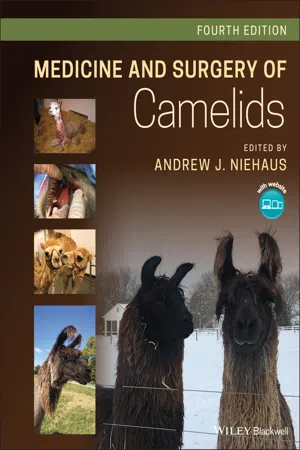
- English
- ePUB (mobile friendly)
- Available on iOS & Android
Medicine and Surgery of Camelids
About This Book
Athoroughly updated new edition of the classic veterinary reference
In the newly revised Fourth Edition of Medicine and Surgery of Camelids, accomplished veterinary surgeon, Dr. Andrew J. Niehaus delivers a comprehensive reference to all aspects of camelid medicine and surgery. The book covers general husbandry, restraint, nutrition, diagnosis, anesthesia, surgery, and the treatment of specific diseases veterinarians are likely to encounter in camelid patients. Although the focus of the text remains on llamas and alpacas, camel-specific information has received more attention than in previous editions with a chapter dedicated to old-world camelids.
The editor revitalizes the emphasis on evidence-based information and pathophysiology and draws on the experience of expert contributors to provide up-to-date and authoritative material on nutrition, internal medicine, and more. A classic text of veterinary medicine, this latest edition comes complete with high-quality color photographs and access to a companion website that offers supplementary resources.
Readers will also find:
- A thorough introduction to the general biology and evolution of camelids, as well as their husbandry and handling
- Comprehensive explorations of camelid physical exams, diagnostics, anesthesia, pain management, and surgery
- Topical discussions arranged by body system including the integumentary system, the musculoskeletal system and multisystem disorders
- Chapters dedicated to camelid radiology, parasitology, and diagnostic clinical pathology
- In-depth examinations of camelid toxicology, neonatology, and congenital diseases
Perfect for veterinary specialists and general practitioners, Medicine and Surgery of Camelids will also earn a place in the libraries of veterinary students and trainees with an interest in camelids.
Frequently asked questions
Information
1
General Biology and Evolution
Taxonomy
General Biology and Genetics
Table of contents
- Cover
- Table of Contents
- Title Page
- Copyright Page
- Dedication Page
- List of Contributors
- Preface
- About the Companion Website
- 1 General Biology and Evolution
- 2 South American Camelid Behavior and the CAMELIDynamics Approach to Handling
- 3 Feeding and Nutrition
- 4 Physical Exam and Diagnostics
- 5 Radiology
- 6 Anesthesia and Pain Management
- 7 Parasitology
- 8 Multisystem Disorders
- 9 Integumentary System
- 10 Musculoskeletal System
- 11 Respiratory System
- 12 Digestive System and Abdomen
- 13 Endocrine System
- 14 Hematology, Clinical Biochemistry, and Fluid Analysis
- 15 Cardiovascular System
- 16 Reproduction and the Reproductive System
- 17 Urinary System
- 18 Ophthalmology
- 19 Nervous System
- 20 Neonatology
- 21 Congenital/Hereditary Conditions
- 22 Toxicology
- 23 Old World Camelids
- Index
- End User License Agreement